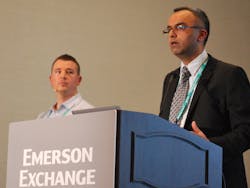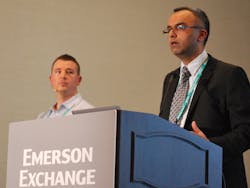NWR Sturgeon refinery saves $6 million on maintenance
You may have started up the first major refinery in North America in 35 years, but what have you done for me lately?
This was the not-so-subtle challenge faced by Northwest Redwater (NWR) Partnership and its NWR Sturgeon Refinery shortly after it completed the first of three design phases and went fully operational in 2020. However, the same spirit that drove NWR and partners including Spartan Controls to design and build the refinery in Redwater, Alberta, Canada, continues to fuel their efforts to use automation to increase efficiency, reliability and sustainability, too.
“The mission of this early stage was developing a maintenance and reliability program to increase the efficiency of field technology resources, spares management, maintenance scheduling and uptime,” said Jamin Hrebeniuk, instrument asset specialist at Spartan Controls. “However, maintaining uptime means reducing some hidden risks beyond the usual maintenance costs. These include environmental regulations, monitoring asset health, having parts available to avoid supply chain issues and using labor resources efficiently.”
Sustainability and finding failures
Located 60 kilometers north of Edmonton, NWR Sturgeon turns bitumen from northern Alberta’s oil sands region into diesel fuel for a variety of automotive and other uses. It completed the first of three design phases before starting up, and presently processes 79,000 barrels per day (bpd) of diluted bitumen into ultra-low-sulfur diesel, low-sulfur vacuum gas oil, diluent and naphtha, and butane and propane.
However, the refinery also supports sustainability by producing CO2 as a key feedstock for the 240-kilometer Alberta Carbon Trunk Line (ACTL), which injects CO2 in wells to improve oil recovery operations and captures CO2 for permanent storage. ACTL is reported to be the world’s largest pipeline for manmade CO2, and has a capacity of 14.6 million metric tons per year (MMt/y) to which NWR Sturgeon contributes 1.2-1.4 MMt/y.
To maintain efficiency and reliability, predict failures and reduce downtime, Hrebeniuk reported that NWR Sturgeon is seeking to predict failures closer to the points where they can start to be detected. This is done by catching issues early with Emerson AMS Device Manager software, and by performing 24/7 asset monitoring with Emerson’s AMS Snap-On software and other best practices.
NWR Sturgeon monitors and collects data from more than 8,700 smart instruments, 261 wireless transmitters, 1,261 control valves with smart positioners and 7,324 smart transmitters. They’re networked via Emerson’s CHARMS electronic I/O, WirelessHART protocol and wireless I/O cards to DeltaV distributed control system (DCS) and AMS Device Manager.
Streamline commission and startup
NWR Sturgeon and Spartan Controls also collaborated during Phase 1 to develop support functions for the refinery based on:
- Using a range of asset criticality levels and AMS Alert Templates for determining required diagnostics levels by criticality and establishing a baseline
- Conducting failure-mode analyses that are application-specific by using AMS diagnostics and alerts to find problems
- Developing job plans, procedures and application-specific maintenance strategies, and finding efficiencies with AMS best practices
- Covering more assets with less inventory by developing a spare parts optimization plan and making it part of the overall inventory management process
Hrebeniuk reported that NWR Sturgeon benefitted by using several labor-saving, digitalized technologies during commissioning and startup:
- Where technicians could typically only examine one device at a time in various locations, AMS users could access thousands of devices from a remote location and view multiple plant points at once.
- Without digital links, managers have limited access to technicians, and communications, questions and progress updates are a challenge. However, AMS users can easily interface with operations and engineering colleagues.
- With data on paper, information accuracy depends on possibly years-old documentation by prior technicians, and questions often remain about who made what changes and when. With AMS, changes are logged digitally in its audit trail, and setups and other actions can be compared to digital project documentation.
Because the more than 8,700 smart instruments at NWR Sturgeon had diagnostics configured, they could also show items like “valve installed” signatures and performance tests indicating who touched them last before servicing. They could also support on-the-fly operational support, troubleshooting and audit configurations. Finally, device groups were organized based on asset criticality, and as an initial baseline, alerts were enabled according to criticality and application-specific maintenance strategies. AMS Alert Monitor and ValveLink were configured, and devices were set up for documentation. This allowed live operations to begin.
“It’s important to have valve assembly baselines because of whatever may happen in the future. You want to be the last one to touch a device, so it’s ready in OEM condition,” said Hrebeniuk. “We ran ours in 2018, and during a small outage in 2019, we noticed some friction in a valve at the top end of its travel. This let us examine it during a planned outage in 2022, and schedule and budget for a repair.”
Other problems and fixes identified during commissioning and baseline testing included:
- Air supply root valve not fully opening, which could have caused startup delays.
- After passing a stoke test, a low CV solenoid was discovered by an updated ValveLink diagnostics test, which includes the valve signature and performance/step test.
- A loose valve stem coupling block was found and had “play” in the connection with the valve stroking after both the travel Hi-Hi and the travel Lo-Lo alerts became active in the alert monitor.
Indicators raise awareness
Once the NWR Sturgeon refinery started normal operations in 2020, AMS Device Manager continued to play a big role, according to Sangha. For instance, AMS Specialist detects and validates alerts, performs initial investigations to determine causes and severity, and corrects minor issues or enters a detailed work order (WO) into Maximo software. These WOs are approved or rejected by decision makers, and corrective jobs are planned as short-order opportunities or deferred to a future outage.
“We have to prioritize because sometimes we can’t bring a process down, or there’s a long lead time to make a repair,” said Sangha. “If a boiler or other super-critical process needs to be fixed, then it’s often deferred, though we try to correct them before they became major reliability issues. If any of these problems are recurring bad actors, we also work with our reliability improvement team (RIT) to decide what to do.”
For example, to prevent a boiler feedwater (BFW) trip, NWR’s staff ran a valve signature for the BFW valve and found that a piston ring was damaged. So, it was repaired during an outage, “as found” and “as left” signatures were recorded, and it returned to satisfactory performance. The “as found” section of the Maximo WO system is where friction was reported on the upper end of the BFW valve’s travel, and recommendation section is where the inspection and failed seal ring were documented.
Similarly, wear to valve seats and plugs can be captured and monitored with ValveLink software’s travel Lo-Lo alert. In a BFW pump valve, potential wear to a seat or plug can be indicated when a valve continues traveling negatively at 0% setpoint. Sangha reported this notification can give users more time to proactively order parts and schedule repairs before complete failures.
“We also got a low air supply alert that was captured by a status monitor doing a baseline test for steady-state supply pressure,” added Sangha. “The supply pressure was low-active, and because poor valve control can equal a boiler trip risk, a work order was submitted. We found that a gauge on a regulator was leaking; the leak was repaired and pressure returned to the expected value.”
Regulations and results
Hrebeniuk added that testing and baselining NWR Sturgeon’s valves and other systems also help it comply with Alberta’s regulatory and reporting requirements. These include the Alberta Energy Regulator (AER), which covers the development of hydrocarbon resources, and the province’s Technology Innovation and Emissions Reduction (TIER) rules on greenhouses gases. For instance, AMS Smart Meter Verification Snap-On software verifies inline and in-service performances with 90-second online tests.
“This is more efficient than traditional methods that are risky due to removing, transporting, testing and reinstalling devices,” added Hrebeniuk. “Likewise, AMS QuickCheck Snap-On software and its check sheets eliminate human errors because we’re using live data with a date/time stamp. It also flags configuration error that may have been introduced at some point and gives us a digital report.”
Sangha estimates that NWR Sturgeon’s implementation of AMS Device Manager and AMS Snap-On have saved the refinery more than $6 million, which is largely attributable to maintenance efficiencies because the software is leveraged sustainably and saves on labor. “Our present maintenance program produces AMS-generated WOs, which drives consistent value for NWR,” said Sandha. “More than 600 predictive and proactive AMS Alert Monitor workorders have been generated and executed. Plus, the data feedback we get provides high value to operations and our RIT for turnaround planning. Plus, third-party, auditor-approved regulatory compliance is easy to manage with AMS-focused work processes.”
Get the best of Emerson Exchange Americas 2022
When the event comes to a close, the best, most important coverage will be compiled into a report. Register now to pre-order the report and be among the first to receive it in your inbox.
About the Author

Leaders relevant to this article:


